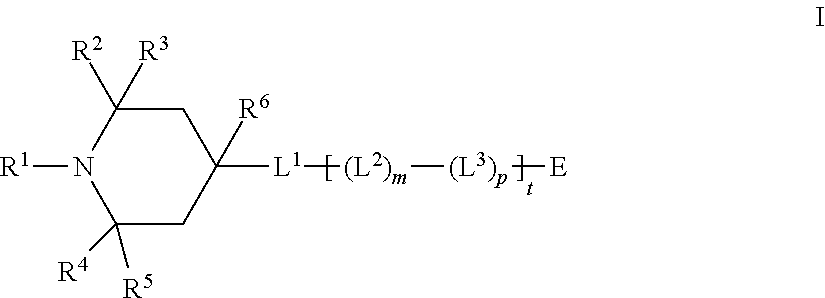Mesogenic stabilizers
a technology of stabilizers and stabilizers, applied in the field ofmesogenic stabilizers, can solve the problems of not being able to achieve the net linear polarization of transmitted radiation, not being well suited to use under certain low-light conditions, and being limited in their ability to store or display information
- Summary
- Abstract
- Description
- Claims
- Application Information
AI Technical Summary
Benefits of technology
Problems solved by technology
Method used
Image
Examples
example 1
[0241]Step 1
[0242]To a reaction flask containing 2000 mL of N,N-dimethylacetamide was added methyl 4-hydroxy benzoate (609 g, 4 mol), 6-chloro-1-hexanol (656 g, 4.8 mol), sodium iodide hydrate (74.4 g, 0.4 mol), and sodium carbonate anhydrous (848 g, 8 mol). The resulting suspension was stirred and heated to about 115° C. for 8 hours. The solution was cooled to room temperature and filtered. The recovered solid was washed with 500 mL of N,N-dimethylacetamide. The filtrate was concentrated under reduced pressure and the resulting residue was poured into 10 L of distilled water under stirring. A white solid was obtained after filtration followed by rinsing with distilled water. The product was used for next step without further purification.
[0243]Step 2
[0244]To a reaction flask containing the product from Step 1 was added sodium hydroxide (192 g, 4.8 mol), water (768 mL), and ethanol (2000 mL). The resulting suspension was heated to reflux for 30 minutes. The solution was cooled to 65...
example 2
[0256]Step 1
[0257]The procedures of Steps 1 and 2 of Example 1 were followed except that 3-chloro-1-propanol and methyl 4-(3-hydroxypropoxy)benzoate were used in place of 6-chloro-1-hexanol in Step 1 and methyl 4-(6-hydroxyhexoxy)benzoate in Step 2. A white solid was recovered as the product. Nuclear Magnetic Resonance (NMR) showed that the product had a structure consistent with 4-(3-hydroxypropoxy)benzoic acid.
[0258]Step 2
[0259]To a reaction flask containing 100 mL of chloroform was added the product from Step 1 (9.81 g, 50.0 mmol), acrylic acid (31.5 g, 437.6 mmol), hydroquinone (2.0 g, 18.2 mmol) and p-toluenesulfonic acid (2.0 g, 10.5 mmol). The resulting mixture was refluxed for 6 hours using a Dean-Stark apparatus. The resulting solution was allowed to cool down to room temperature and diluted with a 3 to 4-fold excess of ether, washed with warm water (50° C.) (100 mL×2) and dried over anhydrous magnesium sulfate. After evaporation of the solvent, the recovered product was re...
example 3
[0273]Step 1
[0274]The procedures of Steps 1 to 8 of Example 2 were followed except that 6-chlorohexan-1-ol and 8-chlorooctan-1-ol were used in place of 3-chloro-1-propanol in Step 1 and 6-chlorohexan-1-ol in Step 3, respectively. A white solid was recovered as the product (3.4 g). Nuclear Magnetic Resonance (NMR) showed that the product had a structure consistent with 4-((4-((8-(4-((4-((4-((6-(acryloyloxy)hexyl)oxy)benzoyl)oxy)phenoxy)carbonyl)phenoxy)octyl)oxy)-4-oxobutanoyl)oxy)-1,2,2,6,6-pentamethylpiperidine as represented by the following graphic formula.
[0275]
PUM
| Property | Measurement | Unit |
|---|---|---|
| temperature | aaaaa | aaaaa |
| temperature | aaaaa | aaaaa |
| speed | aaaaa | aaaaa |
Abstract
Description
Claims
Application Information
 Login to View More
Login to View More - R&D
- Intellectual Property
- Life Sciences
- Materials
- Tech Scout
- Unparalleled Data Quality
- Higher Quality Content
- 60% Fewer Hallucinations
Browse by: Latest US Patents, China's latest patents, Technical Efficacy Thesaurus, Application Domain, Technology Topic, Popular Technical Reports.
© 2025 PatSnap. All rights reserved.Legal|Privacy policy|Modern Slavery Act Transparency Statement|Sitemap|About US| Contact US: help@patsnap.com



